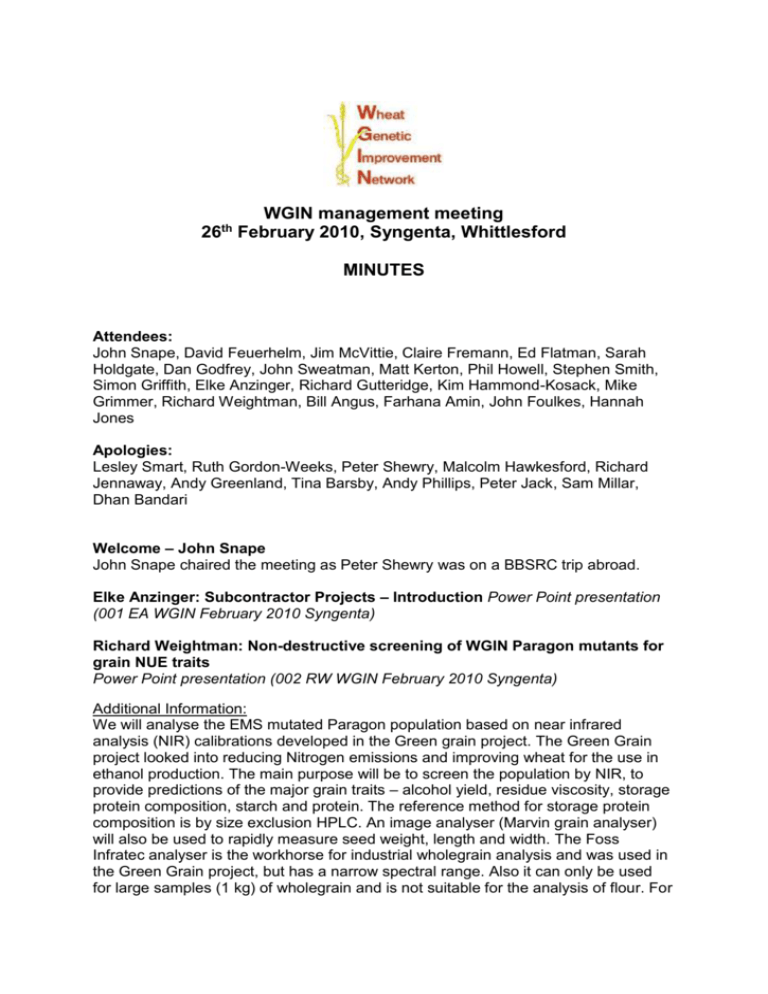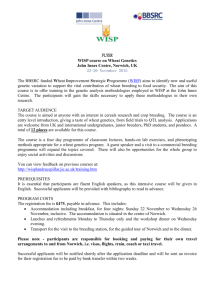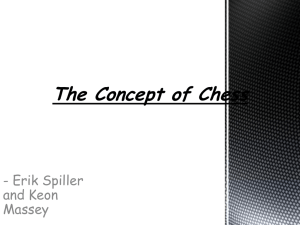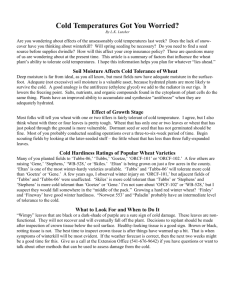Minutes
advertisement

WGIN management meeting 26 February 2010, Syngenta, Whittlesford th MINUTES Attendees: John Snape, David Feuerhelm, Jim McVittie, Claire Fremann, Ed Flatman, Sarah Holdgate, Dan Godfrey, John Sweatman, Matt Kerton, Phil Howell, Stephen Smith, Simon Griffith, Elke Anzinger, Richard Gutteridge, Kim Hammond-Kosack, Mike Grimmer, Richard Weightman, Bill Angus, Farhana Amin, John Foulkes, Hannah Jones Apologies: Lesley Smart, Ruth Gordon-Weeks, Peter Shewry, Malcolm Hawkesford, Richard Jennaway, Andy Greenland, Tina Barsby, Andy Phillips, Peter Jack, Sam Millar, Dhan Bandari Welcome – John Snape John Snape chaired the meeting as Peter Shewry was on a BBSRC trip abroad. Elke Anzinger: Subcontractor Projects – Introduction Power Point presentation (001 EA WGIN February 2010 Syngenta) Richard Weightman: Non-destructive screening of WGIN Paragon mutants for grain NUE traits Power Point presentation (002 RW WGIN February 2010 Syngenta) Additional Information: We will analyse the EMS mutated Paragon population based on near infrared analysis (NIR) calibrations developed in the Green grain project. The Green Grain project looked into reducing Nitrogen emissions and improving wheat for the use in ethanol production. The main purpose will be to screen the population by NIR, to provide predictions of the major grain traits – alcohol yield, residue viscosity, storage protein composition, starch and protein. The reference method for storage protein composition is by size exclusion HPLC. An image analyser (Marvin grain analyser) will also be used to rapidly measure seed weight, length and width. The Foss Infratec analyser is the workhorse for industrial wholegrain analysis and was used in the Green Grain project, but has a narrow spectral range. Also it can only be used for large samples (1 kg) of wholegrain and is not suitable for the analysis of flour. For the analysis of mutants more sophisticated equipment will be used. Aunir, a NIR specialist will carry out further development of the calibrations, JIC will perform the screening and ADAS carry out the final analysis. Gliadins were shown to account for the majority of nitrogen storage in wheat grain. In the Green Grain project, standard varieties showed little variation in gliadin fraction as part of total protein. We expect that near infrared calibrations (NIR) will allow identification of mutant lines which will break this gliadin/total protein content relationship. Q1: The equipment can process a large number of samples. Can you include other doubled haploids (DH) as well, for example Avalon x Cadenza? A: Yes, if there is time. Comment: Yes this can be done, but we have to be careful not to use mutants. Q: Why do you measure length and width? A: Weight, size, length and width are important. Often bold round seeds give a good alcohol yield, Riband is a good example. For small grains length/width analysis helps. Q: Will you be carrying out wet tests? A: Not in this project, but it would be ideal. Q: How many times per line can you scan with the Marvin analyser? A: You can scan as many times as you like. John Foulkes: Exploring the use of Δ180 and total mineral ash content in wheat as a new tool for phenotyping wheat with respect to water inputs Power Point presentation (003 JF WGIN February 2010 Syngenta) Additional information: The subcontractor project will use additional chemical signalling techniques to monitor the drought trial. Carbon analysis of the drought trial is already WGIN funded. CO2 concentration inside the stomatal space (ci) decreases as water use efficiency (WUE) increases. CiCO2 levels decrease either because of stomatal closure or because of a high photosynthetic rate. 1% of CO2 is in the form of the heavier 13CO2. The plant discriminates more against 13CO2 at higher ci which may be associated with greater stomatal conductance when stomata are more open (=low WUE). Hence there is an inverse relationship between 13CO2 discrimination and WUE. Δ180 and total mineral ash content measurements will be added into the existing WGIN drought trials. Samples of dry matter will be analysed. CIMMYT has already done previous work on Δ180 which is a promising tool for a smart screen for stomatal conductance. An increased transpiration rate leads to an increase of Δ180 enrichment in stomatal water. These measurements give an indication of water use (WU), not WUE. Δ180 together with Δ18C also provides more intelligence on underlying drivers for WUE, i.e. stomatal conductance vs photosynthesis.. Increased transpiration is directly related to increased mineral content in the leaf. Measuring mineral ash could predict WU and yield at a lower cost. Mineral ash measurements cost £5,--/samples compared to £15,--/sample for Δ 13C measurements and £25,--/sample for Δ180 measurements. The measurements done in the subcontractor project will give extra power to interpret the physiological basis of the varietal responses to restricted water availability in the WGIN drought trials. Q: Will mineral ash measurements of the flag leaf be affected by remobilization of P to the grain? A: The literature shows that occasionally there is a negative relationship between leaf ash content measured at harvest and grain yield. This may be because lower leaf ash content in these cases is associated with greater remobilization of both assimilate and nutrients from the leaves to the grains .There is, however, generally,, a positive correlation between mineral ash content, WU and yield. Q: Why do you only measure the mineral ash content of the flag leaf and not of the total plant? A: Because approximately 50% of photosynthesis in the yield forming leaves will be carried out in the flag leaf Q: Where will the analysis be carried out? A: We are planning to use a laboratory in Lisbon, Portugal. However I am aware that Eric Ober is using a UK lab. I could look into this. Q: Are you monitoring pest and pathogen attacks during the trial? A: Yes we will carry out routine checks for diseases and standard treatments will be applied. Simon Griffiths: Research update on Objectives 2, 3 and 4 - Tools and Resources Power Point presentation (004 SG WGIN February 2010 Syngenta) Additional information: Avalon x Cadenza DH population: AxC QTLs have put the field trial data into a uniform background (quantitative to qualitative genetics). We are now multiplying and will bag homozygotes to dissect after validation. BC2 seed is just setting. LR19/Sr2S NILs are not widely used in the UK, but CIMMYT has reported yield advantages under irrigated conditions. We have found WGIN and BBSRC Tools and Resources developed COS markers very useful as co-dominant markers for alien segments such as this. The A x C population is a good resource from WGIN and JIC will maintain stocks for distribution. An updated map has been put onto the web recently and there has been a lot of interest in the data. Watkins population: We noticed winter types coming out in some spring x spring crosses, this has slowed down the development of 4 of the 10 single seed descent populations being developed. The Watkins population is part of the wheat prebreeding Lola that Graham Moore submitted to BBSRC in January 2010. We have 800 purified lines in the Watkins collection, some of the 800 continued to segregate so selections of each type have been made. Genotypic core sets have not been done in WGINI. This year we are bulking up the Watkins lines in the glasshouse and will put them into the field later this year. Genotyping has already started with SSR markers Update on projects using WGIN data: - LINK Project using isogenics for 3A - Resource Use Efficiency LINK- ADAS, Limagrain, BASF, JIC. - BBSRC Flowering time and stress in CCPs Reading and JIC. - BBSRC LOLA prebreeding programme- with BBSRCJIC, NIAB, IBERS and RRes Q: Will you put data on isogenics on the web? A: We can add a section for isogenics, but we first need to multiply homozygotes before they can be distributed. John Foulkes: Research update on Objective 9 Power Point presentation (005 JF WGIN February 2010 Syngenta) Additional information: Next year we will assess doubled haploids for drought. In years 1 / 2 phenotyping and data analysis will be carried out. In years 3 / 4 QTL analysis and association mapping will be done. In this year’s field trial plant development is backward because of the severe winter, but plants are well established. Supplementary trials: NIAB backcrosses and CIMMYT synthetic wheat. We could run chemical analysis on exceptional samples. Comment: I would expect a lot of noise, but these are the most advanced samples we have. Comment: We need to meet Eric Ober and the drought LINK steering group. Comment: Eric needs to complete analysis. Populations are already in progress. Q: Will this be a WGIN resource? A: No, because these populations come from the LINK project. Comment: If you want to do crosses in the summer 2010, we need to put plants in the glasshouse now. Q: In the WGIN NUE diversity trials, first wheat is always sown after one year of oats. What about your drought trials? A: The same – first wheat after one year of oats. Richard Gutteridge: Research update on Objective 10 Power Point presentation (006 RG WGIN February 2010 Syngenta) We planted the Gediflux and the Watkins collection for take-all analysis in three 50cm rows with a 50 cm surround. We have a separate trial for the DH lines. At the molecular level Kostya Kanyuka did the analysis for QTLs. Q: Did you check for volunteers? A: There are a few, but not enough to make a difference. Kim Hammond-Kosack: Research update on Objective 11 In WGINI it emerged that MDR308 is resistant to Septoria in the field and the glasshouse. MDR002 is resistant in the field, but susceptibility can be induced when a high spore concentration and optimal infection conditions are used in the glasshouse. The resistance was mapped to a locus on 7A. We now want to do fine mapping to reduce the genetic interval which currently is 0.4 to 2.2 centimorgan. We now have a large batch of F2 seed for fine mapping. (~3000). The introgression of resistance from T. monococcum into T. aestivum was successful in producing F1 plants by embryo rescue, but backcrossing is proving difficult. The F1 for backcrossing have stayed in the vegetative phase for a very long period and the 1st ones are only just starting to flower after 8 months. Q: How long was the vernalisation time? A: 4-6 weeks, as for T. monococcum. Comment: maybe you will be successful when you increase vernalisation time. We plan to put some of the plants back into vernalisation for a second period of cold with the aim of collecting self seed later in the year. Q: Will you be using next generation sequencing? A: Yes We will create two bulks of F4 plants, a resistant and a susceptible bulk and take a pool of each into next generation EST sequencing to identify sequences specific to the R locus containing region on Chromosome 7A. This is being done in collaboration with the Sainsbury Lab, Norwich. Comment: F2 plants can be backcrossed. We have cytology expertise at Rothamsted Research. Wheat workshop in Novi Sad, Serbia One aim of WGIN is to promote broader interaction with the international wheat community. During WGINI we had two workshops with CIMMYT and one with INRA, which were all very useful. So far contact with eastern and southern European wheat workers has been under-exploited. The breeding work in this region is very good, but the level of science is not on par with the UK. We are organising a wheat workshop in Novi Sad, Serbia this June. There is a strong wheat programme at Novi Sad. BBSRC is funding 13 UK people and 9 Eastern and Southern European participants. Funded UK participants are from RRes, JIC, ADAS, the University of Nottingham and the University of Reading. Wheat workers from Serbia, Croatia, Hungary, Romania, Bulgaria and the Czech Republic will attend the workshop. I expect about 50 people will attend the workshop. The workshop will take place on the 15 and 16 June which is about harvest time. The 14 and 17 June are travel days. Transfer from Belgrade to Novi Sad will be arranged. Breeders are welcome to attend on a self funded basis. I need confirmation from breeders who want to attend. People who are attending are expected to give a talk. I suggest the UK breeders decide on someone to give an overview presentation, which then will be followed by 15 min talks of each individual UK breeder. Q: Can the programme/presentations go on the website? A: I have to check. WGIN at Cereals 2010 JIC is sharing a stand with NIAB and TAG and will have the Watkins collection on display. At the RRes stand Malcolm Hawkesford will have posters and 8 display plots of a tall and a short wheat variety, each at four N levels to give people an idea of the WGIN diversity trial. Richard Gutteridge is preparing a T. monococcum/Septoria display and is planting two A x C lines with high and low take all inoculum. AoB Publications: Barraclough, P. B., Howarth, J. R., Jones, J., Lopez-Bellido, R., Parmar, S., Shepherd, C. E. & Hawkesford, M. J. (2010) Nitrogen efficiency of wheat: genotypic and environmental variation and prospects for improvement. European Journal of Agronomy. Jing, H-C, Bayon, C., Kanyuka, K., Berry, S., Wenzl, P., Huttner, E., Kilian, A. and Hammond-Kosack, K. E. (2009) DArT markers: diversity analyses, genomes comparison, mapping and integration with SSR markers in Triticum monococcum BMC Genomics, 10: 458. doi:10.1186/1471-2164-10-458 17 pp V.E. McMillan, K.E. Hammond-Kosack and R.J. Gutteridge Evidence that wheat varieties differ in their ability to build-up inoculum of the take-all fungus, Gaeumannomyces graminis var. tritici, under a first wheat crop submitted to Plant Pathology - 26th Feb 2010. Simon Griffiths: A x C flowering time published Simon Griffiths: Height/Stature – accepted Simon Griffiths: Grain size in Plant cell Grant applications: Kim Hammond-Kosack: Phenotyping the Watkins collection for take all resistance as part of the wheat pre-breeding Lola submitted by Graham Moore to BBSRC (Jan2010) Kim Hammond-Kosack: Take all inoculums build-up and elite wheat differences – submitted to TSPTSB with three breeding companies (Feb 2010) Kim Hammond-Kosack: BBSRC strategic LOLA grant application. Genetic resistance for control of take-all disease of wheat. PI – Anne Osbourn, to be submitted (JIC), Co-Is Cristobal Uauy (JIC), Andy Greenland (NIAB) and KHK and Richard Gutteridge (RRes) submitted expression of interest in March 2010 Simon Griffiths: LINK??? Simon Griffiths: BBSRC grant with Reading University Kim Hammond-Kosack together with Andy Phillips and Cristobal Uauy applied for a BBSRC resources grant on Tilling of the EMS mutagenised population Meetings: Next WGIN stakeholder meeting: 17 November 2010 at RRes Next WGIN management meeting: Friday 16nd July, the meeting will take place at JIC and will include a field trip. Core management group afternoon meeting (update on milestones) Farhana will find out if Defra is planning an economic audit of WGIN. International workshop for 2011: Elke to find out when the North American wheat workers workshop will take place. The next WGIN newsletter will focus on the new resources which have become available within the project – so start to send out for inputs.






